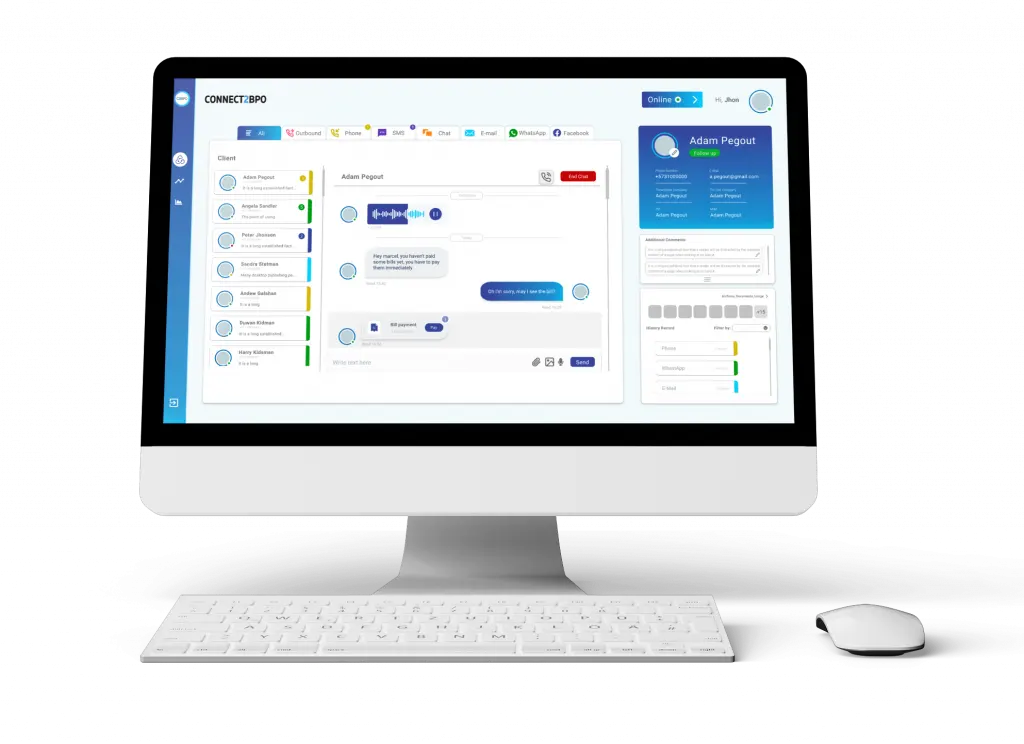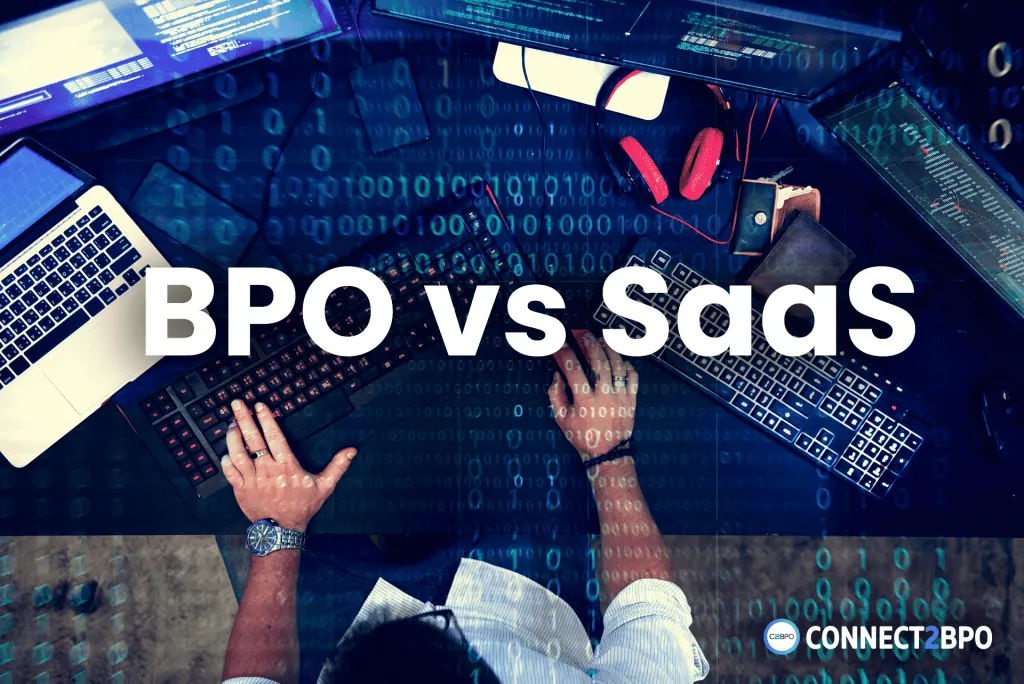When automation is considered for scaling up the business, Software as a Service (SaaS) and Business Process Outsourcing (BPO) are often mentioned in the same line, but both are entirely different services.
Under BPO, the outsourced processes are shifted to the service provider. Companies that utilize these services are looking at improving their efficiency rather than the use of specific methods/software. In SaaS Software as a Service, the authority and responsibility to use the purchased software service remain with the company.
What is Software As a Service SaaS?
Software as a service (SaaS) refers to an application serving the end-user through the internet. SaaS works on the cloud distribution/delivery model. A SaaS provider can host the applications on its servers independently or can use a third-party cloud service. SaaS products are available for both B2B and B2C users.
SaaS applications are generally accessible through web browsers or remotely, with a small installation possible. Companies using SaaS applications need to pay a fee to the provider. It can be subscription-based or usage-based.
Why would a business choose SaaS over a BPO?
- A company prefers SaaS over BPO if its data storage requirement is limited.
- If a company urgently needs to scale up with a new client, it can purchase a SaaS service.
Software As a Service Examples
- Salesforce: A cloud-based customer relationship management (CRM) platform that offers a suite of applications focused on sales, service, marketing, and more.
- Google Workspace (formerly G Suite): A suite of productivity tools including Gmail, Google Drive, Google Docs, Sheets, Slides, and more, offered as a cloud-based service.
- Microsoft Office 365: Similar to Google Workspace, Office 365 provides cloud-based access to Microsoft Office applications like Word, Excel, PowerPoint, Outlook, and others, along with collaboration tools and services.
- Dropbox: A cloud-based file hosting service that offers file synchronization, personal cloud, and client software. It allows users to create a special folder on their computers, which Dropbox then synchronizes so that it appears to be the same folder (with the same contents) regardless of which device is used to view it.
- Slack: A cloud-based team collaboration tool that offers chat, file sharing, and integrations with other tools and services, aiming to streamline communication within organizations.
- Zoom: A cloud-based video conferencing service that provides video conferencing, online meetings, chat, and mobile collaboration.
Business Process Outsourcing
Business process outsourcing (BPO) refers to utilizing third-party services for certain business operations. It involves delegating business processes to an external service provider to manage and streamline these processes. A business process outsourcing company can offer horizontal offerings across specific industries and vertical offerings that demand thorough industry-specific process knowledge.
BPO services are provided across industries with commonly outsourced processes of customer service, accounting, data mining, IT services, payroll, regulatory compliance, and human resources management.
BPO allows the workforce to remain in their home country while contributing their skills outside the geographical boundaries. It is called offshoring if the service provider is located outside the country, several time zones away, and Nearshoring if the provider is in the neighboring region or one or two time zones away.

How does the Cost of BPO vs SAAS work?
When it comes to cost, companies using SaaS applications need to pay a fee to the provider. With subscription-based or usage-based monthly or yearly payments, SaaS solutions may be attractive. But when it comes to ROI, companies prefer BPO solutions. Data shows that an efficient BPO provider can reduce operational costs by 30%.
If a company wants to pay for what it uses and the limited facilities of SaaS providers do not create an issue at all, a company is good to go with SaaS at a minimum cost.
Another scenario for cost is hiring and training costs. A BPO service provider can mirror your existing business workflow on the cloud. Or, if required, it can customize the workflow and take the responsibility of training. Since the hired team is an expert in its field, it will handle all assigned business tasks with great competency. On the other hand, when the host implements new functionalities to SaaS applications, they are rolled out to all users, due to which companies need to provide extra time and resources for training.
BPO vs SAAS
Similarities:
- Third-party Service Providers: Both BPO and SaaS involve third-party service providers delivering solutions to businesses. In BPO, these solutions often revolve around outsourced business processes, while in SaaS, they are software applications delivered over the internet.
- Subscription Model: Both BPO and SaaS often operate on a subscription-based model. BPO services may be charged based on the volume of work or through fixed monthly fees, while SaaS applications typically require users to pay a recurring subscription fee for access to the software.
- Scalability: Both BPO and SaaS solutions offer scalability, allowing businesses to adjust the level of service or software usage based on their needs. This scalability can help businesses accommodate growth or fluctuating demand without significant upfront investments.
Differences:
- Focus: BPO primarily focuses on outsourcing specific business processes or functions to a third-party provider, such as customer service, IT support, or HR operations. In contrast, SaaS focuses on delivering software applications over the internet, covering a wide range of functionalities like CRM, project management, or email marketing.
- Service vs. Software: BPO involves outsourcing actual business processes, where the service provider handles the execution of tasks on behalf of the client. SaaS, on the other hand, provides access to software applications hosted by the provider, enabling users to utilize the features and functionalities of the software remotely.
- Customization: BPO services often allow for more customization to fit the specific needs and preferences of the client’s business processes. Providers may tailor their services to align with the client’s workflows and requirements. In contrast, while some level of customization may be available in SaaS applications, they are typically designed to serve a broader audience with standardized features and configurations.
- Control: In BPO arrangements, the client retains control over their overall business strategy and operations, while outsourcing specific tasks to the service provider. With SaaS, the provider maintains control over the software application itself, including updates, maintenance, and security. Clients have control over how they use the software within their own operations but rely on the provider for ongoing support and enhancements.
Here’s a revised version of your article incorporating the requested keyphrases and keywords:
BPO vs SaaS: Which is Best for Your Software Development Needs?
When it comes to software development outsourcing, businesses often face a choice between Business Process Outsourcing (BPO) and Software as a Service (SaaS). Both models offer distinct advantages, but which is the right fit for outsourcing software development?
BPO provides comprehensive services, including software development outsourcing services. Software outsourcing companies within the BPO model can manage entire projects, from design to deployment, offering a hands-on approach.
On the other hand, SaaS delivers software solutions via cloud platforms. While not as hands-on as BPO, SaaS allows for flexibility and scalability in software outsourcing without needing to manage infrastructure.
Choosing between BPO and SaaS depends on your project’s scope and whether you need full-fledged outsourcing software development or specific software outsourcing solutions.
Which is Easier to Implement?
When it comes to quick setup and deployment, SaaS applications win as it is already configured in the cloud. However, with numerous benefits of BPO over SaaS, BPO solutions are the preference of most companies.
BPO allows businesses to swiftly offload entire processes to specialized service providers, eliminating the need for internal restructuring or software integration. Additionally, BPO providers often offer expertise and resources that streamline the transition process, ensuring seamless integration with existing workflows.
Despite the initial setup time, BPO solutions can ultimately lead to greater efficiency and cost savings in the long run, making them an attractive option for businesses seeking comprehensive outsourcing solutions.
Connect2BPO is the best BPO option to work with
At Connect2BPO, we are ready to improve the efficiency in your business. Check the industries we have worked with.
Optimize your team with our staffing and human talent service in Colombia. We provide temporary services and outsourcing solutions to enhance your business’s activities. Trus in a company with extensive experience in contact center solutions and back office services, we can build the perfect team that fits your company’s needs and meets the requirements of quality and compliance objectives.



